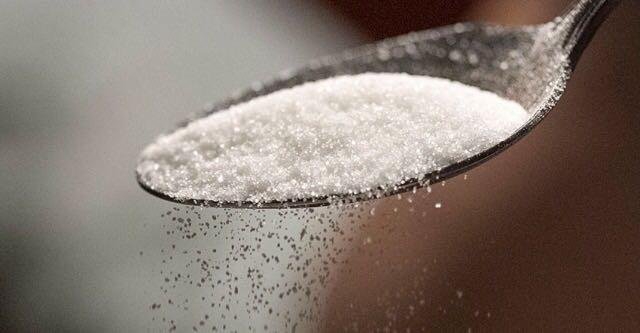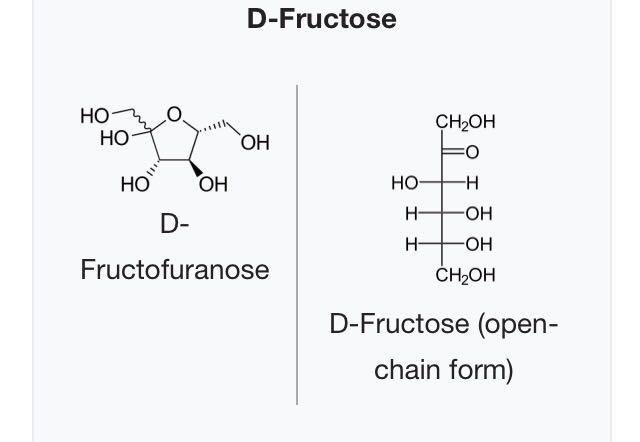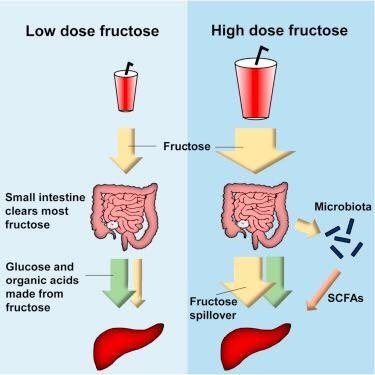HEALTH SCIENCE: THE SMALL INTESTINE IS THE FIRST STOP FOR PROCESSING FRUCTOSE NOT THE LIVER .
sweet tooth sucrose also known as table sugar, is made from a mixture of fructose and glucose . These two sugar molecules are been handled by our body differently. But the updated research in mice shows the small intestine helps the liver by the first crack at metabolizing fructose.
First of all what is Fructose ?
Fructose also known as fruit sugar is a ketonic monosaccharide found in many plants, where it is often bonded to glucose to form the disaccharide , sucrose.
A ketose is a monosaccharide containing one ketone group per molecule. The most common ketose is the dihydroxyacetone, which is said to have only 3 carbon atoms.
A monosaccharide also known as simple sugar are the basic units of carbohydrates, they are fundamental unit of the carbohydrate and cannot be broken further to simpler compounds. In other words monosaccharide katoses are reducing sugar agencies, because they can interconvert into Aldoses .
The fructose , glucose , and the galactose (galacto- + -ose, milk sugar), are the three dietary monosaccharide and then absorbed directly into the blood during digestion.
Fructose could be found in honey, tree and vine fruits, flowers, berries, and most root vegetables.
diagram
properties
- Chemical formula • C6H12O6
- Molar mass • 180.16 g·mol−1
- Density • 1.694 g/cm3
- Melting point • 103 °C (217 °F; 376 K)
- Solubility in water • ~4000 g/L (25 °C)
- Mag susceptibility(χ)• −102.60×10−6 cm3/mol
note : the fructose was discovered by French chemist *Augustin-Pierre Dubrunfaut in 1847.
Explanation
The liver is more like a pinch hitter to the small intestine, when it comes to processing the fructose . Fructose consists of energy and for the body use these energy, the body needs to convert it into another type of simple sugar called glucose. No doubts, the fructose could be metabolized in both the liver and the small intestine, but most believed the liver was mainly responsible for the process.
Well steemians, a new study in mice suggests otherwise, showing that sugar found in honey , corn syrup-sweetened, even products like liquid soda are transformed in the small intestine. As a substitute the liver only steps in when the small intestine is congested .
"In this way, the small intestine shields the liver from dangerously high doses of fructose", says Joshua Rabinowitz , a metabolism researcher at Princeton university.
- did you know extra fructose puts the liver at risk such as fatty liver disease , and also brings about the risk of obesity and type 2 diabetes . From the research made made Rabinowitz and his colllegues ran an experiment by feeding a mice an equal mixture part of glucose and fructose, some certain carbon atoms had been swapped out for a slightly heavier form of carbon. This gave the researchers the opportunity to track any form of sugar being transformed and where there metabolites, was ending up. Samples was taken by the researchers from different mouse organs, and then identified the molecules with heavier carbon when separating out the metabolites by weight.
In the process of this research, the Researchers discovered metabolites from labeled fructose molecules abundant in the small intestine, and only small amounts in the liver and in the vein that connects the small intestine to the liver, and then discovered that lot of glucose was found in the vein, with signs showing some of the glucose has been chemically transformed from fructose molecules in the small intestine . The vein linking the intestine and liver had a higher intake of fructose to glucose than at lower sugar dose. This illustrates the small intestine was passing some fructose to the liver.
Gilles Mithieux a nutrition researcher at the French National Institute of Health and Medical Research in Lyon and who wasn't part of the study says " The study’s focus on how the body handles fructose at different doses shows the workload breakdown between the two organs and suggests a protective role for the small intestine" .
Luc Tuppay, a physiologist at the University of Lausanne in Switzerland who wasn’t part of the study said, it's not really right to compare sugar doses between humans and mice, which helps in expending more energy relative to the body weight than humans, so it's meaningless the scale up the doses of sugar by body weight.
** Diagram**
note
did you know scientists still contemplates on maybe the small intestine is a safer place to process fructose than the liver, Rabinowitz says.
did you know Isotope tracing reveals that the small intestine metabolizes most dietary fructose.
did you know excess fructose spills over to the liver and colonic microbiota.
did you know intestinal fructose clearance is enhanced by feeding.
did you know Excessive consumption of sweets is a risk factor for metabolic syndrome.
did you know the small intestine converts dietary fructose into glucose me organic acids .
did you know a major chemical feature f sweets is fructose .
did you know the ties between fructose and disease, the metabolic fructose in mammals remains understood.
did you know High doses of fructose (≥1 g/kg) engulf intestinal fructose absorption and clearance.
did you know Glucose and fructose are both hexose sugars with the same molecular formula (C6H12O6).
Summary
In conclusion, the research made so far and also the experiments, shows that the small intestine shields the liver from toxic fructose exposure.
Thanks for viewing steemians, I hope to get your feedback 👨🏻🔬 •
refrences
smallintestineprocessesfructosefirst


